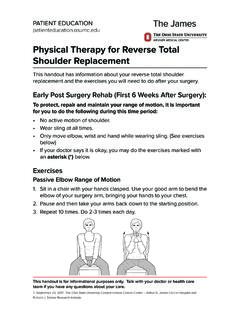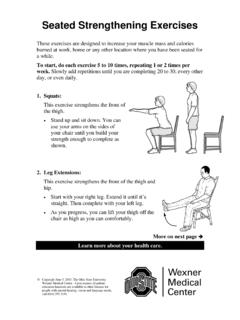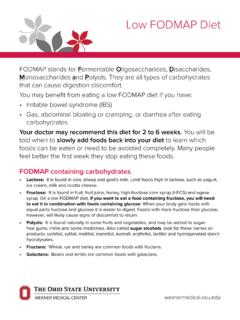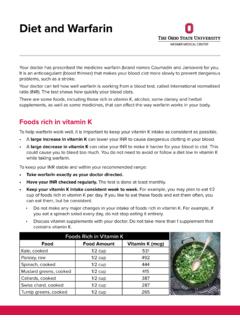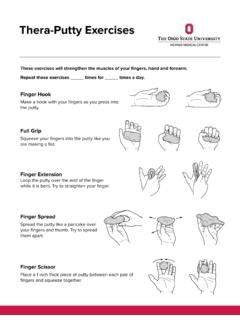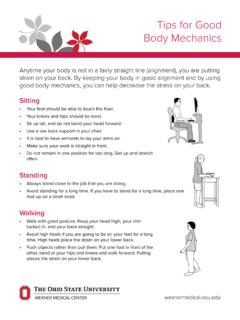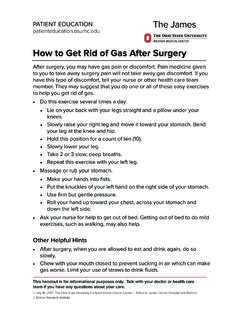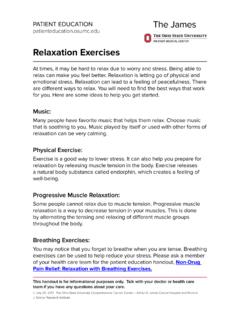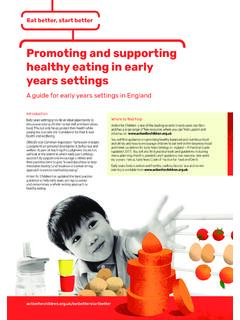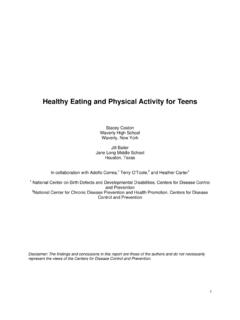Transcription of Eating Healthy on a Budget - patienteducation.osumc.edu
1 Eating Healthy on a Budget Shopping Tips and Menu Ideas Eating Healthy on a Budget can feel challenging if you don't know where to start. Here are some tips to help you purchase healthier foods without overspending. Before you shop, plan ahead Create a Budget for food. Have a dollar amount in mind and do your best to stick to it. Look at past grocery store receipts as a starting point. Make a list of what food you already have on hand in your refrigerator, freezer, and pantry. See what's on sale for the coming week. Head to your grocery store's website and make a list of what foods are going to be on sale that week, such as fruits, vegetables, proteins (meats, poultry, fish, eggs, beans, etc.)
2 , and whole grains. Make a meal plan for the week using the lists of what food you have on hand and what is going to be on sale. If you need recipe ideas, use the Internet, friends, and family, or borrow a cookbook from the library. Be realistic. If you only have 20 minutes to make dinner, don't choose a recipe that will take 45 minutes. Plan to use leftovers for a few lunches or dinners throughout the week to reduce time spent in the kitchen. Cook once and eat twice. See the menu section of this handout for an example. Plan snacks too! Avoid soda and other sweetened beverages and snacks. They cost a lot and lack nutrition.
3 Create a grocery list once you have your meal ideas. To make shopping easy, create food categories. Write out how much money is. spent on each item or food group. This can help you plan your next trip to the store too. Item Amount Cost Produce Apples 1 bag $ Meats/Poultry/Fish Ground turkey 1 pound $ It is okay to change your mind based on cost or what is available when you get to the store. The key is to stick to your Budget while Eating Healthy . 2 Save money and shop smart Look for in store sales or specials. Look for the store brand or generic brand. The same food will cost less and taste the same.
4 Use coupons for items you buy frequently. You can find coupons online and in the newspaper. Look to the top and bottom of the grocery store shelves. More expensive items are placed on the middle shelves. Grab items from the back of the shelf. Grocery stores often place the newest items behind the oldest items. Sign up for a shopping card if the store has one. This is not a credit card. It just gives you more money off the food you buy, and can even help you save money on gas. Eat before you shop. If you shop hungry, you are more likely to put food items in your cart that you don't need. Use a smaller cart to control how much food you can actually put in.
5 Don't buy anything extra that is not on your grocery list. Fruits and vegetables Buy fresh fruits and vegetables that are in season: Summer melons, corn, tomatoes, peaches, berries, bell peppers, cucumbers, eggplant, green beans, zucchini, yellow squash, cherries Autumn pumpkins, squash, apples, mango, beets, Swiss chard, cauliflower, mushrooms, parsnips Winter oranges, grapefruit, apples, pears, Brussels sprouts, cabbage, kale, potatoes, sweet potatoes, winter squash Spring asparagus, broccoli, collard greens, spinach, carrots, peas, strawberries, apricots, lettuce, radishes, celery Other tips: Produce prices are often cheapest on Wednesdays.
6 Eat frozen or canned fruits and vegetables when fresh ones cost more or are not in season. Frozen ones have less salt than canned. Drain and rinse canned vegetables for less salt. Buy canned fruits that are lite or use natural juice and not syrup. It is not necessary to buy organic fruits and vegetables to get good nutrition. Buy what is affordable for you! 3. Dairy Try low-fat cheese or yogurt. Buy the big or family-size plain flavored yogurt and add a touch of honey or fruit at home instead of buying individually packaged and pre-sweetened yogurt. Drink milk with 2% or less fat. It still has Vitamin D in it.
7 Always check the expiration date to make sure you are getting the freshest product. Grains (bread, cereal, rice, pasta). Eat whole wheat or whole grain bread, pasta, rice, and cereal. Buy plain, unflavored grains in bulk instead of pre-flavored or individual packages. To reduce waste, freeze bread and save what you need for later. Hot cereals, like oatmeal, grits, and cream of wheat, are cheaper and have a long shelf life. Proteins (meat, poultry, canned/dried beans, nuts, tofu, eggs, fish). Beans: Add a few meatless meals every week. Beans cost less than meat and are good for you. Try baked beans, fat-free refried beans, kidney beans, chickpeas, great northern beans, and black beans.
8 If buying in the can, buy no-sodium or low-sodium, and rinse well under tap water before Eating . Or, try dried beans and soak them before cooking to reduce cooking time. Beans can also take the place of part of the meat in a recipe. Choose low fat meats and buy in the big or family-size package when it is on sale. Split it into several meals and put it into the freezer until needed. Lean cuts of beef include eye of round roast and steak, top round roast and steak, top sirloin steak, sirloin tip side steak, bottom round roast and steak, and 90% or leaner ground beef. Poultry: Choose white meat and remove skin.
9 Turkey can cost less than chicken. Consider buying ground turkey or chicken as a substitute for ground beef or mixing it half and half. Eggs: Cook eggs as a main dish since they are cheap, easy to make, and high in protein as well as many vitamins and minerals. Fish: To save money, look in the frozen aisle for fish when fresh fish isn't on sale. Skip the breaded options. Canned salmon or tuna packed in water, not oil, are also good options. Snacks Avoid chips, candy, and desserts. Instead, eat fruit, raw veggies with hummus or a small amount of ranch dressing, a small piece of low-fat cheese with whole wheat crackers, low-fat yogurt, a cup of nuts such as almonds, walnuts, or peanuts, or 3 cups plain popcorn.
10 These snacks will give you energy that lasts longer than other snack foods. Make your own snack foods by taking what you already have in the house. 4 Beverages Stick with mostly water. An average family can spend almost $1,000 a year on soda alone! Bottled juices, sports drinks, and even bottled water can shrink your Budget . Drinking tap water is good for your health and your wallet. If you don't like the taste of tap water, buy large jugs of water instead of individual bottles to save money. To improve the flavor of water, add a squeeze or a wedge of fresh lemon, lime, or orange, or drink herbal or decaf tea (unsweetened).
